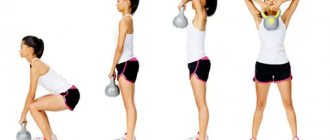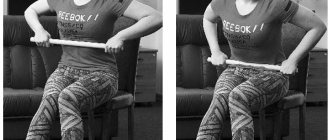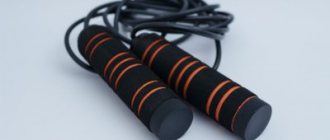- July 10, 2018
- Workouts in the gym
- Vorotyntseva Sofia
“If you love to be slim, you also love to go to workouts!” - this is the law for any girl who wants to have a beautiful body. Most of us are only chasing a beautiful buttock shape, mistakenly thinking that by training the muscles of the arms and back, we will become the owner of a masculine body. Today we will dispel the most popular myths, learn how to create our own training program, and also find out which foods will be beneficial for our body and how to motivate ourselves to exercise.
Features of the female body
Before drawing up a training plan, we need to study some features of the female body that will help you achieve the desired result.
Women's bodies are very different from men's, so if you find a men's workout, don't assume it's perfect for you. Firstly, girls are physically weaker than men. If you come to the gym, you don’t need to take the heaviest dumbbells and push yourself to the point of exhaustion. It’s better to take an average weight and work through each exercise carefully. Since the female body is more resilient, the number of repetitions will always be greater than that of men.
Every trainee needs to know that during the month her body goes through 4 periods: follicular, ovulation, luteal and menstruation.
During the follicular period (lasting from 7 to 22 days), you should slightly increase your carbohydrate intake, as this will be used to energy your muscles. At this time, it is advised to increase the intensity of training and add weight.
The period of ovulation (lasts 24-48 hours) is characterized by an increase in the level of estrogen in the body, which affects the strength of collagen in the body. This period is the most dangerous because if you do the exercises incorrectly, you risk injury or muscle strain. However, it is during this period that muscle productivity increases by 15%, so ovulation days are ideal for intensive training.
For girls, training on the back and arms in the luteal phase will be the best solution. Don't overload your body: Do yoga or Pilates, but don't overload your lower body as you won't get any progress or benefit.
Avoid any exercise during the first two days of your period. Already on the third day, you can gradually begin to do cardio exercises, and in the following days, return to your usual training during the follicular period.
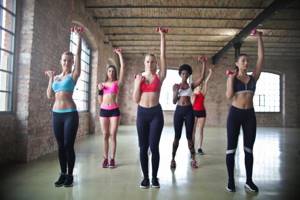
Muscles and their features
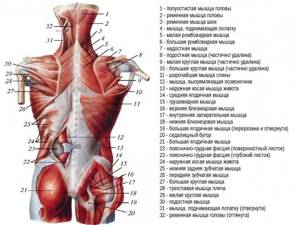
The middle part of the back includes a fairly large group of muscles. This creates certain difficulties when pumping this department. First of all, it is worth noting the upper sector of the longissimus muscle, the round muscle (major and minor), the posterior serratus muscle tissues (upper and lower), the spinalis muscle, and the latissimus muscle. Together, they are all aimed at ensuring the work of the upper limbs, promote the retraction of the arms back, and are responsible for lowering the raised limb and its rotation. Provided that the shoulder is in a fixed position, these muscles support the torso and lift it.
The latissimus muscle is of greatest importance. She is one of the largest and strongest in this group. And the space it occupies covers almost the entire upper back. The main purpose of this muscle tissue is to pull the arm back and bring the shoulder directly to the body. And horizontal or vertical traction is effective for loading this muscle.
If there is a need to work out the middle part of the back, then it is the latissimus muscle that should be given special attention. After all, its correct development will not only give the back a beautiful relief and shape, but will also significantly improve the overall performance of this department.
Myths and reality
Another point that needs to be carefully studied before drawing up a training program.
- “If I train my arms, shoulders and back, soon my body will look like a man’s.” No! The female body is designed in such a way that you will never look like a man, unless, of course, you take any substances. Such workouts will give you beautiful relief and fit.
- “If I train as often as possible, I will achieve immediate results.” This will only result in injuries and strains to your muscles. Muscles are a living part of the body that needs to rest. Therefore, you should have an interval of 2-3 days between workouts.
- “The longer I train, the better the results will be.” Your results do not depend on the duration of your training, but on their quality.
- “Any workout on the Internet will do for me.” No. Each girl must make her own individual plan. If you work out with a trainer, he will select the most suitable workout for you. If you are a beginner, then do not take on professional training, but start from the very basics.
- “If I sweat a lot, I’ll lose weight faster and become more toned.” Of course, in this case you will lose a lot of water from your body. But the amount of water is quickly restored in the body. And many, taking advantage of this myth, begin to put on warm clothes, wrap themselves in cling film and actively train. Such manipulations can lead to thickening of the blood, and subsequently to the formation of blood clots and a slowdown in metabolism. Wear light clothes for training so as not to harm yourself!

Exercises to develop the muscles of the middle back
Both machines and exercises with free weights are suitable for developing the muscles of the middle back. However, it is the simulators that will provide the greatest targeting. Although free weights should not be neglected.
T-bar row
Here, both the lower deltas and the rhomboid muscle are developed. The weight should be selected in such a way that you can perform 8 to 10 repetitions with the maximum range of motion. Moreover, without cheating.
This is a basic exercise that perfectly “gets” to the deepest muscles of the back.
If a T-bar is not available, you can build a similar one yourself by attaching a spacer to the end of a regular bar. Some athletes additionally wrap the spacer, for example, with elastic bandages to ensure the stability of the entire structure.
Row of two dumbbells to the waist from a bent over position
Starting position: the body is tilted parallel to the floor, legs are bent, dumbbells are held in lowered hands. Pull the dumbbells up to your waist and make sure that your elbows do not spread out to the sides. Try to exclude the biceps from the work, and perform exclusively with the efforts of the back. At the top point, pause for 10-20 seconds and slowly return the dumbbells to their original position.
This exercise should be performed with two dumbbells, not one. As for the weight, it should not be too heavy so that you can properly feel the entire movement and perform a static stop at the top peak point for at least 10 seconds.
You can perform this exercise not standing, but lying face down on a horizontal or inclined bench.
Lower block row on the simulator
The muscles of the middle back are worked very well. At the bottom point of the trajectory, you need to try to lower the weight as much as possible, you can even tilt your body and bend your legs. This way you can achieve maximum stretching of the back muscles. When moving up, you need to squeeze your shoulder blades together as much as possible and pull your shoulders back. The number of repetitions is from 10 to 12.
Crossover
This is an arm raise on a machine. When performing this exercise, you need to keep in mind that: if your hands are placed in front of your chest, then the rear deltoid muscle is activated. Therefore, it is better to spread your hands behind your head. The arms are straightened as much as possible, providing tension to the back muscles. Naturally, you need to delay for a few seconds - do not forget about static voltage. Then the weight slowly returns to its original position. The number of repetitions per set is from 10 to 15.
The really important thing here is not to “throw” the weight, but to ensure that it is lowered in a controlled manner.
Preparation for training
Before training, you need to braid your hair so that it does not interfere during exercise, put on light clothes, lay a mat on the floor, prepare water and the necessary items for exercise (dumbbells, expander).
Once you are ready to begin, you need to warm up well to prepare your body for the stress. The warm-up takes about 15 minutes. Since we will be working with the belt of the upper limbs, we need to knead it as thoroughly as possible.
- We start by tilting the head. Smoothly tilt your head forward and back. Then we bend to the sides. Number of repetitions: 10 times for each incline.
- Head rotation. We make 15 circular movements of the head clockwise and vice versa. During the exercise, focus your gaze on one point.
- Shoulder rotation. Raise your shoulders up, down and in a circle. Then we do the exercise in the opposite direction. Number of repetitions: 25 times.
- Wave your arms. Raise your arms up and begin to rotate them clockwise and then counterclockwise. After this, rotate your hands in different directions (i.e. with one hand you rotate towards you, with the other - against, and vice versa). Number of repetitions: 15 times in each direction.
- Rotation of the elbow joint. Bend your elbows and begin to perform circular rotations. This exercise is similar to the previous one. Follow the same pattern. Number of repetitions: 15 times in each direction.
- Rotation of the brush. Lock your hands together and rotate them in different directions for 30 seconds.
- Flexion/extension of fingers. Do this exercise as efficiently as possible for 30 seconds.
- Raising hands. Bend your elbows and place them perpendicular to your body at chest level. We move our shoulders back, straightening our elbows, turn to the right and try to connect our shoulder blades. We repeat the same with the other side. Number of repetitions: 17 times on each side.
- Torso rotations. We raise our arms at shoulder level and begin to perform turns to the right and left. We turn only with the torso, leaving the pelvis in a stationary position. Number of repetitions: 10 times on each side.
- Circular movements of the body. We perform the movement clockwise and counterclockwise. The pelvis is motionless. We do the exercise for 30 seconds.
- Body bends. Analogy with head tilts. Number of repetitions: 10 times on each side. We perform the exercise smoothly, without sudden movements.
- Rotation of the pelvis. The body remains motionless. Rotate clockwise and counterclockwise. Number of repetitions: 10 times on each side.
- Rotation of the knee joint. We bring our knees together and place the palms of our hands on them. Rotate clockwise and counterclockwise. Then we put our feet shoulder-width apart and rotate our knees inward. Number of repetitions: 15 on each side.
- Rotation of the ankle joint. We stand on our toes with one foot and perform rotations in different directions. We do the same for the other leg. Number of repetitions: 20 times in each direction.
- Calf raise. We try to rise on our toes as high as possible. Number of repetitions: 20 times.
This warm-up will take you about 12 minutes. If you feel that your upper limbs are not warmed up enough, then repeat the arm warm-up exercises.
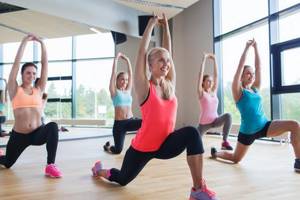
Exercises[edit | edit code]
It is unlikely that you will be able to properly work out the muscles of the middle back only with exercises with free weights; the use of exercise machines here is an urgent necessity. But we will start, nevertheless, with free weights.
T-bar row[edit | edit code]
One of the best exercises both for gaining overall back mass and for developing the lower trapezius, and at the same time the rhomboid muscles. The emphasis of the exercise is on peak contraction. The weight is selected in such a way that you can perform 8-10 repetitions per set without “cheating” - in a pure style. One problem: the good old T-bar is extremely rare in gyms these days. You can try to build it from a regular bar, resting one end of it on a spacer (it is far from certain that such a structure will be stable) or find a replacement for this exercise. An exercise that is most suitable as a replacement is:
Bent-over rows of two dumbbells[edit | edit code]
Yes, yes, two, not one - this is how you can most fully engage the muscles of the middle back. Take two dumbbells in your hands, the weight of each of which will be slightly less than the weight of the dumbbell with which you are used to performing rows with one hand. A few is 30 percent. Bend over, keeping your upper body parallel to the floor, dumbbells hanging in your outstretched arms. Without spreading your elbows to the sides, but keeping them as close to your body as possible, pull the dumbbells up, moving your shoulders back and squeezing your shoulder blades. At the same time, the body rises by about 35-45 degrees. Pause at the top. The number of repetitions is the same as for the T-bar row. An interesting variation of this exercise is to row dumbbells to the waist while lying face down on an incline bench. The weight of the burden in this case should be even less.
Lower block thrust[edit | edit code]
This is perhaps the best exercise for developing the muscles of the middle back. And this is exactly the exercise that 90% of people in the gym do incorrectly. Therefore, we will focus on the technique of performing this exercise. At the bottom of the range of motion, try to release the weight as much as possible, leaning forward and stretching your back muscles, keeping your legs slightly bent and your back slightly rounded. During the movement, try to move your shoulders back as much as possible, at the end point of the amplitude, lean back a little, arching in the lower back, and bring your shoulder blades together as much as possible. Perform 10-12 repetitions per set in this style.
Breeding in the crossover simulator[edit | edit code]
If you spread your arms in front of your chest, then the main “impact” falls on the rear deltoid. You and I will raise our hands behind our heads. Everything is as usual in this exercise: we take the left block (without a handle) with our right hand, and the right one with our left hand and cross our arms behind our head. We straighten our arms, trying to tense the muscles of the middle of the back as much as possible, and freeze in this position for a few seconds. It is best to do this exercise with a reduced amplitude, then the muscles of the middle back are felt most acutely. The weight of the weight is selected so that you can perform 10-12 repetitions.
Arm and back training program for girls
So, first we need to determine our level of preparation. If you are just starting to train your arms, back and chest, then you are a beginner. If you are already familiar with physical activity on these muscles, then your level of training is average. And if you have been involved in sports for more than one year and know first-hand about such training, then your level of preparation is high. The main thing in training for women on the shoulders and back is to determine the level of training.
Now let's look at each level of training.
- Girls who have just started their sports journey should do 4 exercises of 3 approaches in training for one muscle group. The break between approaches is 30 seconds. The first two exercises are basic. They are usually the heaviest and require the most effort. The last two are easier but require a lot of repetition. Let's present our training in the form of a table.
| Exercise name | Execution technique | Number of repetitions |
| Reverse chair push-ups | We turn our backs to the chair and lean on it with our hands. Legs bent at 90 degrees, lower straight down until arms are bent at 90 degrees | 5 |
| Reverse fold | We get into a plank position on our hands. Raise the pelvis up, then return to the starting position | 5 |
| Raising your arms to the sides | Take light dumbbells in both hands (if you don’t have them, you can take books). Raise both arms to shoulder level, then lower. When you reach the bottom, don't relax your arms | 10 |
| Diagonal rook | We lie on our stomachs, stretching our arms forward. First we raise our left hand with our right leg, then our right hand with our left leg. At the highest point we tense the muscles of the back and buttocks | 5 |
Exercises can be replaced with others or the number of repetitions added. If you feel that you are not getting enough load, move on to the next level of training.
- At an average level of training, the number of exercises increases to 5-6, and the number of circles remains the same. The exercises are a little more complicated, but are performed in the same order: 3 basic, 2-3 for a special muscle group.
| Exercise name | Execution technique | Number of repetitions |
| Push ups | Keep your body straight. Bend your arms to an angle of 90 degrees. We don’t bend our back. If you feel like you can’t cope, you can do the exercise on bent knees | 8 (on bent knees - 10) |
| Abduction of arms while lying down | We lie on our stomachs, stretching our arms forward. Raise your torso slightly so that your head and arms do not touch the floor. In this position, we move our elbows back, trying to bring our shoulder blades together as much as possible. Returning to the starting position | 8 |
| Plank arm raises | We get into a plank position on our hands. Alternately raise the right and left arm so that it forms a continuous straight line with the body | 8 (4 for each hand) |
| Bent over arms spread | We bend to an angle of 45 degrees. We spread our arms out to the sides as much as possible. In this exercise, your back should be straight and motionless. | 10 |
| Pelvic lift | We lie on our backs, legs bent at the knees. Raise and lower the pelvis. We do not relax the muscles at the lowest point | 10 |
Be sure to follow the technique of performing each exercise!
- We have reached a high level of preparation. The number of exercises increases here to 7-9, and the number of approaches to 3-4.
| Exercise name | Execution technique | Number of repetitions |
| Diagonal strip | We lean on our left arm and right leg (or vice versa). The body forms a straight line. Tighten your abs and don’t bend your lower back | 30 seconds |
| Push-ups with rotation | We do push-ups and turn our torso at the top point. When turning, your arms should be straight | 10 |
| Jogging on your hands | We place our hands on the floor in front of our feet. We begin to take “steps” with them, the legs should remain motionless. We take 5 steps and get into the plank position on our hands. Let's go back in the same steps | 30 seconds |
| Leg rotations while lying on your back | Lie on your back, hands on the floor. We bend our knees and begin to perform turns, first in one direction, then in the other. We try to touch the floor with our knees | 10 |
| Hand raises | We raise our arms straight forward, to the sides, up, to the sides, forward. You can use dumbbells or books for weighting. | 10 |
| Plank on hands | The body is straight, we lean on our hands. During the exercise, do not bend your lower back | 30 - 60 seconds |
| Cat bend | Standing on all fours, we try to arch our back as much as possible (you should form a “hump”), pulling your head towards your chest. Then we bend our back and throw our head up | 10 |
These tables show an approximate workout for girls on the arms and back. You can replace exercises, increase or decrease the number of repetitions, and make your own changes. For greater convenience, keep a diary where you will describe your training in detail. It is worth noting that the training program for girls on the arms and back is strictly individual.
To track your workout results, use a measuring tape. It is not recommended to do 2 workouts per day. It is also undesirable to train your back and arms on the same day. It is better to alternate exercises for these muscles within the complex.
The good thing about doing a home workout for your arms and back is that you won’t be embarrassed by anyone and will work through each exercise carefully, even if it doesn’t work out the first time.
Exercises to train the middle part of the back.
- Stretching the back muscles.
Stand up straight, interlace your fingers and turn your palms outward. Rounding your shoulders, reach your arms forward. The exercise is suitable for warming up and can be performed by beginners. No equipment required.
- Bent-over kettlebell rows with both hands.
Take two weights and lean back slightly. Lift weights from the floor while bent over. This is the starting position. Then, pull them towards you, bending your elbows, trying to keep your shoulder blades together and keeping your back straight. Lower the weights. Additionally trains the biceps and latissimus dorsi muscles. For this exercise, you must already have experience in the field of bodybuilding.
- Upper body stretching.
Sit on a chair with your back straight. The feet should be parallel to each other on the floor. Interlace your fingers at the back of your head. Lower your chin and spread your elbows to the sides. Rotate your upper body, trying to reach your elbow to the knee of your other leg. Suitable for beginners. This stretch activates the muscles of the lower back, trapezius, neck, and broad back.
- Traction on the lower block.
You will need a cable trainer with a V-shaped handle. Sit in the machine, rest your feet, bend your knees slightly. Lean back until your torso is parallel to your legs. Pull your chest forward, straighten your back, bend your lower back. You need to feel the tension in the widest part of your back. This is the starting position. Keeping your torso still, as you exhale, pull the handle towards you until your hands touch your stomach. Tighten your back muscles and hold this pose for a few seconds. As you inhale, return to the starting position. To avoid injuring your back, avoid jerking and sudden body movements. Can be performed with palms facing up or down. The exercise is suitable for beginner athletes.
- Smith machine bent over row.
Adjust the height of the bar on the Smith machine so that it is 2 inches below your knees. Bend them forward until your torso is parallel to the floor. Keep your head straight. Hold the bar with your palms facing down and remove it. The bar should be held in outstretched arms, perpendicular to the body. This is the starting position. Bend your elbows and, as you exhale, pull the barbell towards you. When finishing the exercise, tense your back muscles for 5-6 seconds. And while inhaling, lower the barbell to its original position. Perform 5-6 repetitions. The exercise is suitable for beginners and affects the biceps, shoulders, and latissimus dorsi muscles.
- Lumbar triangle stretch.
Lie on your back with a pillow under your back at the top. Spread your shoulder blades, crossing your arms over your chest. This is the starting position. Then lift your hips, transferring your weight onto the roller. Turn to each side, holding for 10-30 seconds. The exercise is good for beginners. Activates the trapezius muscles.
- Bent-over barbell row with a reverse grip.
Hold the barbell with your palms facing up. Bend your knees and lean forward, back straight, head raised. Keeping your torso motionless, as you exhale, pull the barbell towards you. When finishing the exercise, tense your back muscles and hold the tension for several seconds. As you inhale, lower the barbell.
Experts do not recommend doing this exercise if you have back or lower back problems. To be safe, take lighter weights. The exercise is suitable if you have some experience. Includes the lats, biceps and shoulders.
Chest training program
When training your pectoral muscles, you are also training your neck. It is important to remember that during training you should feel tension in the chest area. These simple exercises can be added to your regular routine and performed 3 times a week.
- Palm squeezing. Place your palms together and press for 10 seconds. For this exercise, you can use a spring expander for the pectoral muscles.
- Bringing your hands together. We bend our arms at the elbows, begin to bring them together and spread them in front of us. To make it more difficult, you can use dumbbells.
- Wall push-ups.
It is worth noting that many shoulder exercises also train the pectoral muscles. For example, hand planks or push-ups.

Features of back muscle training
The significant size of the muscles requires quite serious loads to be applied to them. Working with extreme weights should not raise any questions or difficulties, but it is important to correctly calculate the set of activities. Here it is worth aiming for the long term. After all, rapid pumping of this muscle tissue is impossible. It is considered optimal to divide the entire planned load into 2 classes during the week. Moreover, it is better to provide a full break between workouts. For this, 3 days will be enough.
The exercises themselves are best done in an explosive style. Its essence is as follows. When pulling up, the upward jerk should be as fast and strong as possible, and the lowering should be done at the minimum possible speed.
It is impossible not to note the usefulness of pumping this part of the back when combining the load with other muscles. The back and chest are best combined. The muscles of these groups are antagonists, and working them together allows you to get the maximum effect. The situation is similar with the back and deltoids. And although this combination is nothing special, professional athletes use this combination quite often. And the exercises themselves have a fairly high rate of efficiency and productivity.
The middle part of the back is a section with a large number of muscles, and each of them performs a specific function. Exercises for these muscle tissues can be selected in a variety of ways and with any load. It is only important to properly balance the exercises to work out each individual muscle as fully as possible. An excellent result is guaranteed.
What should you eat to maintain results?
In addition to physical activity, you must follow a certain menu. For muscle growth, protein intake is of course necessary. The amino acids that make up them are the main building blocks of our body. Milk, cottage cheese, eggs, beef, chicken breast and fish are foods with maximum protein content. For muscle growth, you need to consume 2-2.5 grams of protein per 1 kilogram of weight.
Carbohydrates also play a big role in your body. Eat carbohydrate foods before and 4-6 hours after exercise. Before training, you will have a boost of energy, and after it, your body will recover faster. The level of this substance in the body depends on your workout. If you do not train very intensely, do a small number of repetitions (3-5), then you need to consume about 2 g / 1 kg of weight. If your workout is moderate activity, then the level of carbohydrates will be 2-4 g / 1 kg, with high physical activity - 4-6 g / 1 kg, and with several workouts per day - more than 6 g / 1 kg. Rice, buckwheat, honey, beans, potatoes, apples, grapes, and freshly squeezed juices are rich in carbohydrates.

The benefits of training
So what are the benefits of arm, shoulder and back training for girls? Playing sports helps strengthen ligaments, reduces the risk of heart attacks, improves blood circulation, and accelerates metabolism. Your toned body will look attractive. In addition, training improves sleep and acts as an anti-stress: you will not complain about being overweight because you regularly engage in physical activity. Back training will help correct postural defects and your skin will look healthy.
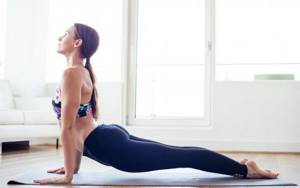
How to force yourself to train?
Back and shoulder training for women is one of the most difficult, so it is important to properly motivate yourself to do the exercise. If the benefits of exercise don’t convince you, then try turning physical activity into a game. For example, write on a piece of paper that there are 11 steps (11 workouts) left until the end of your monthly plan; at the end of each step, fulfill your small desire: buy a new book or dress, go to the cinema, have a picnic, etc. The most important thing is that your training is a joy and brings you only pleasure!

Workout apps
- Keep - workouts at home. The app contains workouts for both fat burning and muscle building. More than a hundred workouts developed by specialists.
- "Fitness for Women: Women's Workout." Provides workouts for every part of the body, divided into fitness levels. It is one of the best apps on the Play Store in the Health and Fitness category.
- "Fitness plan 30 days" - workouts at home. The app includes a 30-day plan for each muscle group. There is a workout for women for the back and arms.
- Nike Training Club - workouts and fitness plans. An application that will provide you with the highest quality workouts. There are training programs for the chest, arms and back. Each exercise is accompanied by a video with the technique, a nice interface and an excellent “pumping” of your muscles!
- “Beautiful Chest, Arms and Shoulders” is the best application that provides workouts for girls on their arms and back. In addition, the application allows you to create your own workout.
- Arms & Back 21 is an application that will provide you with a quality training program for your back and arms. In the app, after each workout, you accumulate points, for which you can buy a workout of a different level.
Such applications are excellent cheat sheets for beginners: you can get acquainted with a lot of new exercises and their correct technique, get some advice and, of course, get in shape! Become the best version of yourself every day! Good luck to you in all your sporting endeavors!
Iron Health
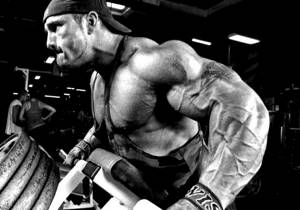
It's no secret that a well-developed back is extremely important for a competitive bodybuilder. However, a beautiful back is necessary not only for professionals, but also for any self-respecting athlete. Today we will talk about the features of mid-back training, which is of decisive importance for those athletes who plan to compete at various levels. After all, having a wide back is not enough: if the middle part of the back is poorly developed, you will not see success.
What muscles belong to the middle of the back? This area includes the lower trapezius, as well as the rhomboid major and minor muscles. The development of these muscles as a whole determines the appearance of the back, along with its width and separation. Remember the photographs of Dorian Yates and Roni Coleman - examples of detailing and massiveness of all areas of the back.
Features of the training
You will not be able to pump up the muscles of the middle of your back in isolation - there are simply no exercises that would specifically affect these muscles. But there are a large number of subtleties with which you can maximally involve the lower trapezius and the muscles under it in the work. The following factors are important for the development of the middle back: grip, amplitude of exercises and the amount of working weight. The main factor of these is the amplitude of the exercises, which should be maximum in all target exercises. In this case, the shoulders should be brought back, and the shoulder blades should almost touch. Only by following these techniques can you force all the necessary muscles in the middle of your back to work. This technique is only feasible when using a narrow grip.
As for the working weight, it should not be excessive. Moreover, its value should be slightly less than usual. This is explained by the fact that with a large working weight, the athlete simply will not be able to move his shoulders as far back as possible. In addition, most of the load will go to the biceps. Such traction will not bring any effect.
What exercises are needed?
It is impossible to pump up the middle of the back well with exercises with free weights alone. The use of simulators is a necessity here. However, despite this, we will start the training with free weights.
T-bar row
The T-bar row is considered one of the best exercises for gaining muscle mass in the mid-back muscles - the lower trapezius and rhomboid muscles. The emphasis of this exercise is on prolonging the peak contraction by using an isometric pause. The working weight is selected in such a way as to perform 8-10 clean repetitions without cheating.
As a rule, most gyms do not have a special bar and machine for T-rows. Therefore, you can use a regular classic barbell, hanging weights on only one end.
Bent-over row of two dumbbells
It is this type of rowing that provides targeted load to the muscles of the middle back, in contrast to traditional dumbbell rows with one hand. Choose dumbbells of a weight that is slightly smaller than your usual working weight. Lean forward, keeping your upper body parallel to the floor, grab the dumbbells and lower them down with your arms outstretched. Without spreading your elbows out to the sides, pull the dumbbells up, moving your shoulders back and squeezing your shoulder blades together as much as possible. At the top point, maintain a 1-2 second pause. The number of repetitions is the same as for T-bar rows. Lower block thrust
This exercise is considered the best for pumping up the middle of the back. However, 90% of athletes perform it incorrectly, negating all its benefits.
At the lowest point of the amplitude, try to release the weight as much as possible, leaning forward and stretching your back muscles. At the same time, bend your legs slightly and slightly round your back. During movements, move your shoulders back as far as you can, arching at the lower back. Perform lat pulldowns for 10-12 reps per set.
About the role of static load
Training the mid-back muscles involves using an isometric pause, that is, prolonging the peak muscle contraction as much as possible. To ensure even greater muscle pumping, you can not pause for 1-2 seconds, but linger for 10-12 seconds, performing static hold of the working weight. This technique will allow more muscle fibers to be involved in the work, which will have a positive effect on the overall growth of muscle mass in the middle of the back.
When and how to download?
You can include training the muscles of the middle back in a separate workout, or you can simply include several exercises for this group in your usual back routine. It is best to start training by performing heavy basic exercises, and after them move on to auxiliary exercises.
If the middle of your back is your weakest area, then start your workout with exercises for this muscle group. The effectiveness of this approach was proven by Arnold Schwarzenegger. As for approaches and repetitions, allocate 2-4 sets of 10-12 repetitions each for each exercise. In total, you will do about 8-9 working approaches during the workout.
Video on the topic : “Mid-back training using seated lat pulldowns”



